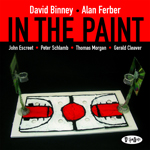By John Kelman
With an influence felt, perhaps, as much or more in the work of others than in his own record sales, alto saxophonist David Binney rarely co-leads groups, but his longstanding collaboration with pianist Edward Simon has been fruitful in more ways than one. Sharing compositional and conceptual duties frees him to focus more on his playing, and that’s always a good thing, as Binney’s innovative writing has sometimes overshadowed the fact that he’s also a damn fine performer. Co-leading brings even greater breadth to the table, making In the Paint—a first-time shared leadership with trombonist Alan Ferber—another inspired pairing.
Nearly 15 years Binney’s younger, Ferber has been increasingly in the public eye on guitarist Charlie Hunter’s succinct Gentlemen, I Neglected to Inform You You Will Not Be Getting Paid (Spire, 2010), bassist Todd Sickafoose’s remarkable Tiny Resistors (Cryptogramophone, 2008) and percussionist/composer John Hollenbeck’s equally outstanding Eternal Interlude (Sunnyside, 2009). He also guested on Binney’s last album with Simon, Océanos (Criss Cross, 2007), but with In the Paint his voice is more definitive—splitting compositional duties with Binney nearly down the middle, alongside an uncovered gem and three freely improvised alto/trombone duets that demonstrate the leaders’ shared propensity for pulling surprising form from the ether.
Despite being instantly recognizable, Binney’s writing remains fresh and unpredictable. With a septet also featuring the twin-chordal attack of pianist John Escreet and vibraphonist Peter Schlamb, and a rhythm section powered by bassist Thomas Morgan and drummer Gerald Cleaver, the opening “Growin’ Up” combines mixed meters and unhurried motivic development, built around unison lines that give way to knotty counterpoint, creating a propulsive, mid-tempo context for Binney’s needle-threading solo. Ferber’s title track is equally intricate, a syncopated bass line doubled by Escreet underpinning warm voicings and an equally unhurried melody that sets up an exhilarating alto solo that reaches comfortably into the horn’s upper register before Ferber takes over, his burnished tone possessing a hint of grit as he lithely winds his way through the changes.
Cleaver and Morgan swing with gentle authority on Binney’s “Everybody’s Wonderland,” shifting seamlessly between 5/8 and 6/8, while Escreet takes a lengthy solo that confirms his status as another young player to watch. Schlamb, another up-and-comer, delivers an ethereal solo, filled with cascading lines, on Binney’s “Paris,” where darker colors support its serpentine melody. Unencumbered by preconception, Binney and Ferber engage on three spontaneous miniatures: the vivacious “Interlude I”; sparer “Interlude II”; and “Interlude III,” where the two orbit around each other, occasionally intersecting. “Lautir”—by the perennially overlooked woodwind multi-instrumentalist Ken McIntyre, best-known for his work with Eric Dolphy and Charlie Haden’s Liberation Music Orchestra—becomes a brief feature for Cleaver.
Binney and Ferber’s shared appreciation for complex yet eminently accessible writing—performed by an ensemble rich in texture and a simmering rather than steaming approach—makes In the Paint a captivating listen. A strong addition to Binney’s discography, it’s also clear notice that Ferber is an artist to watch beyond his inestimable appearances as a sideman.
Track listing: Growin’ Up; In the Paint; Everybody’s Wonderland; Interlude I; Paris; Edinburgh; Icecave; Interlude II; La Taqueria; Magnolia; Lautir; Interlude III; Our Inventions.
Personnel: David Binney: alto saxophone; Alan Ferber: trombone; John Escreet: piano; Peter Schlamb: vibes; Thomas Morgan: bass; Gerald Cleaver: drums.







